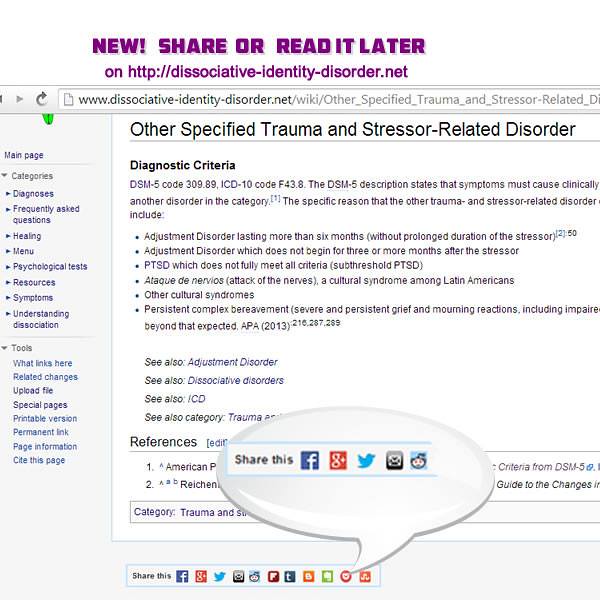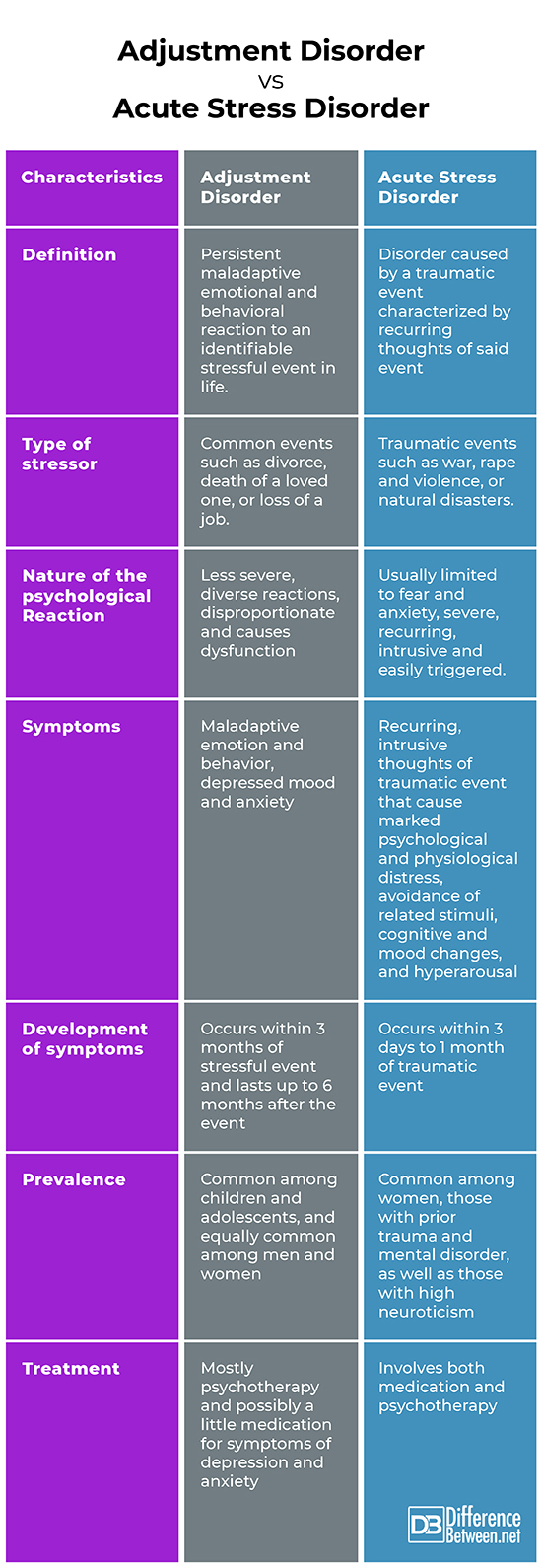Difference Between Adjustment Disorder and Acute Stress Disorder
Adjustment disorder and acute stress disorder are two different psychiatric diagnoses that are characterized by psychological, emotional and behavioral disturbances that occur in response to a stressor that can be objectively identified. The psychological disturbances occur when a person’s ability to adjust and cope are overwhelmed by major stressors or trauma. Both are documented in the Diagnostic and Statistical Manual for Mental Disorders (DSM 5) and categorized under the heading “Trauma and Stressor Related Disorders” along with Post-traumatic Stress Disorder, or PTSD.
Though similar in that both conditions are maladjustment to stress and trauma, the two are different mainly in the severity and nature of the stressors and psychological disturbances or symptoms as well as the timeframe within which the symptoms occur. Each disorder is discussed further below as well as their differences.
What is Adjustment Disorder?
Adjustment disorder is a diagnosis to maladaptive emotional or behavioral reaction that occurs within several months of a stressful event or change in the life of a person. The stressor causes more distress than would be expected given the circumstances. It may also be that the stressor results to an obvious decrease of physical, social or occupational functioning of the person without any outward evidence of mental or emotional distress.
The types of stressors in a diagnosis of adjustment disorder can be almost anything commonly experienced, such as a divorce or death of a loved one. Also, the stressor can be a single event like moving away for college, or can also be multiple stressors as in marital problems and losing a job at the same time. The emotional and behavioral reactions are diverse and are typically described as maladaptive. Symptoms may also include depressed mood and anxiety but do not meet criteria for other mental disorders. These symptoms are usually not severe but disproportionate to the severity or intensity of the stressor. Even so, there is still a marked reduction in the person’s functioning. For this diagnosis, symptoms must begin within three months of the onset of the stressor. These symptoms may also last up to six months after the stressor has ceased or if the person has already adapted to the situation.
Adjustment disorder is common in children and adolescents and equally prevalent among males and females. In general, treatment aims to relieve symptoms and to return the person to at least the baseline functioning. Medications are seldom prescribed unless there are accompanying symptoms such as depression and anxiety. Psychotherapy is the usual treatment of choice although therapy may vary from patient to patient as well as clinician to clinician.
What is Acute Stress Disorder?
Acute stress disorder is another diagnosis for psychological dysfunction caused by trauma and stress. The psychological dysfunction or symptoms occur within three days to one month after a traumatic event. These symptoms are often severe, recurrent and easily triggered, characterized by intrusive memories, avoidance of related stimuli and changes in mood and arousal that impair daily functioning. Persistence of symptoms beyond one month changes the diagnosis to post-traumatic stress disorder.
Events that cause acute stress disorder are traumatic even to witnesses of such events. These traumatic stressors include war and combat, rape and violence or natural disasters. People who have acute stress disorder usually re-experience the traumatic event in the form of unwanted but intrusive thoughts and memories, dreams, nightmares or flashbacks that cause marked psychological and physiological distress. Resemblances of any form to the traumatic event also cause distress. A person with acute stress disorder is also understandably averse or overly avoidant of these stimuli. Symptoms also include changes in thinking and mood such as feelings of shame, doubt and anger as well as inaccurate blame of self or others. Another group of symptoms is hyper-arousal which includes hypervigilance, excessive startle response aggression and recklessness.
Acute stress disorder occurs in 20-50% of victims or witnesses of traumatic events that involve interpersonal assault as in rape or a shooting, and occurs in less than 20% of those who experience trauma without interpersonal assault like in accidents or natural disasters. It is also more prevalent among women, those who have experienced prior trauma and prior mental disorder, and to those with high neuroticism, avoidant coping personality and with elevated startle response. Treatment for acute stress disorder involves both medication and therapy in equal measure and importance.
Difference between Adjustment Disorder and Acute Stress Disorder
Definition
Adjustment disorder is the persistent maladaptive psychological reaction to an identifiable stressful event in a person’s life. Acute stress disorder is severe psychological and physiological reactions to a traumatic event characterized by reliving traumatic events, avoidance, changes in thinking and mood and hyper-arousal.
Type of stressor
The stressors in adjustment disorder can be anything and are commonly experienced such as divorce, death of a loved one, or loss of a job. The stressors that cause acute stress disorder are usually traumatic as in war, rape and violence, and natural disasters.
Severity of psychological reaction
Psychological reactions in adjustment disorder are considered less severe, diverse reactions, disproportionate to the intensity of the stressor and causing dysfunction. Psychological and physiological reactions in acute stress disorder are more severe, usually limited to fear and anxiety, recurring and easily triggered.
Symptoms
Symptoms of adjustment disorder include maladaptive emotions and behavior, impairment in social and occupational functioning as well as depressed mood and anxiety.
Development of symptoms
Symptoms for adjustment disorder occur within three months of the stressful event and may last up to six months after the stressor. Symptoms of acute stress disorder occur within three days to one month of the traumatic event and persistence of symptoms beyond one month changes diagnosis to post-traumatic stress disorder.
Prevalence
Adjustment disorder is more common among children and adolescents, and equally common among men and women. Acute stress disorder is more common among women, those with prior trauma and mental disorder as well as those with high neuroticism a high startle response.
Treatment
Treatment for adjustment disorder is mostly psychotherapy and possibly a little medication for symptoms of depression and anxiety. Treatment for acute stress disorder involves both medication and psychotherapy.
Adjustment Disorder vs Acute Stress Disorder
Summary
- Adjustment disorder and acute stress disorder are abnormal reactions to stressor and trauma.
- Adjustment disorder is caused by common life stressors like divorce, death of a loved one or loss of a job.
- Acute stress disorder is caused by a traumatic event either directly experienced or witnessed such as war, violence, and natural disasters.
- These disorders result from an overwhelmed ability to cope with major stressors and trauma.
- Difference Between Hematoma and Melanoma - February 9, 2023
- Difference Between Bruising and Necrosis - February 8, 2023
- Difference Between Brain Hematoma and Brain Hemorrhage - February 8, 2023
Search DifferenceBetween.net :
Leave a Response
References :
[0]Image credit: https://www.flickr.com/photos/traumaanddissociation/14590708167
[1]Image credit: https://www.flickr.com/photos/schnappischnap/8970209474
[2]Hooley, Jill M., James N. Butcher, Matthew K. Nock, and Susan Mineka. Abnormal Psychology Global Edition. England, UK: Pearson Education Limited, 2017. Print
[3]Lal, Rachna, and Dean F. Mackinnon. "Adjustment Disorder." Johns Hopkins Psychiatry Guide. October 29, 2017. https://www.hopkinsguides.com/hopkins/view/Johns_Hopkins_Psychiatry_Guide/787068/all/Adjustment_Disorder (accessed September 25, 2019).
[4]Hsih, Katie W., and Dean MacKinnon. "Acute Stress Disorde." Johns Hopkins Psychiatry Guide. July 1, 2017. https://www.hopkinsguides.com/hopkins/view/Johns_Hopkins_Psychiatry_Guide/787067/all/Acute_Stress_Disorder (accessed September 25, 2019).



